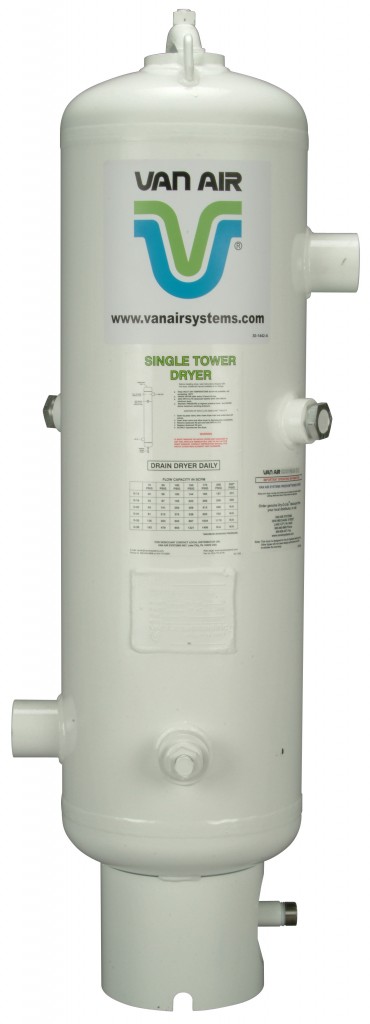Wet Compressed Air – Basic Air Dryer Trouble Shooting
You have water in your compressed air line and blame it on a malfunctioning dryer. That might be the case, but often it’s “something else”.
To find that “something else” you need to look at components and conditions upstream of the air dryer.
Start at the compressor. Is it a reciprocating, screw, or centrifugal compressor? Is it lubricated or non-lubricated? Does it have an integral after cooler or a free-standing after cooler? Lubricated compressors inherently carry some oil downstream. Reciprocating compressors discharge even more oil than screw compressors. Are bulk liquid separators and coalescing filters in place to manage the oil? You should avoid introducing oil to the air dryer.
Check the discharge temperature of the compressor with an infrared temperature gun. For compressors that have an integral after cooler the compressor discharge temperature should be a maximum of 20⁰ F above ambient temperature. Be sure to check the temperature when the compressor is fully loaded.
If the customer has a free standing after cooler the discharge temperature should be a maximum of 20F above ambient.
If a cooler is not performing in this range, it is undersized or dirty. Or both. Cleaning the exterior surface of the cooler helps with more efficient heat transfer. Also flush the cooler with a solvent periodically to remove build up. Compressed air dryers do not like hot air. Heat could be the cause of your dryer’s problems.
Now look at the condensate drains. There should be automatic condensate drains on each  moisture separator, receiver tank, and filter upstream of the compressed air dryer. Be careful here! Stand back when opening any drain because you can ruin a good pair of shoes or pants with oily condensate!
moisture separator, receiver tank, and filter upstream of the compressed air dryer. Be careful here! Stand back when opening any drain because you can ruin a good pair of shoes or pants with oily condensate!
A failed drain is a leading cause of dryer failure. Introducing liquid into a dryer should be avoided.
Now check filters to make sure they are not exhibiting excessive pressure drop. The filters should have some type of indicator for monitoring differential pressure. It may be a pop-up indicator, pressure gauge, or a dial indicator. In my view, 5 PSID is the upper boundary of acceptable pressure loss through a filter.
Also, be on the lookout for extremely low pressure drop across a filter. If the pressure drop is less than 1 PSID most likely the filter element is missing or ruptured.
Filters that are not working properly will allow oil and/or free water to carry over to the dryer. Oil and liquid water contaminates and ruins the desiccant in regenerative dryers. The performance of a refrigerated dryer is also negatively affected by non-performing coalescing filters. Oil coats the interior surface of a refrigerated dryer’s heat exchangers. This reduces the heat transfer capabilities of those heat exchangers and effects the dew point performance of the dryer. Any free water carryover can overwhelm the separator on the refrigerated dryer and result in the water being carried downstream of the dryer.
Deliquescent dryers are a little more forgiving when it comes to oil and water carryover. While Van Air Systems highly recommends installing a coalescing prefilter for oil removal, a little oil won’t hurt the performance of the dryer. The deliquescent dryer also has a generously sized sump for collecting condensate so if the dryer is hit with a slug of free water it will not be compromised like a regenerative or refrigerated dryer would.
The bottom line here is filter elements should be physically inspected every 6 months at a minimum even if the differential pressure indicator indicates an acceptable pressure drop.
Finally, check for open by-pass valves. Dryers are often installed with by-pass valves and piping to facilitate service. If a by-pass is accidentally left open, wet air will escape past the dryer and contaminate the air system.
Only after checking all of the above items, take a look at the dryer itself. It is tough to know how a dryer is performing if there’s no dew point monitor installed. Yet here are a few quick tips and tricks.
A refrigerated dryer should have low and high refrigerant gauges. Read the dryer’s instruction manual and confirm that pressure in the refrigeration circuit is correct. If the readings are outside the specified parameters, a refrigeration technician is needed.
Make sure the refrigerated dryer’s condenser isn’t dusty. A fouled condenser is a leading cause of dryer problems.
Ambient temperature is very important too. Most refrigerated dryers sold in North America are designed for a maximum ambient temperature of 100⁰ F. If your dryer is operating in an area that warmer than this, you might have problems.
Regenerative dryers usually have a color change moisture indicator installed on the dryer. If the indicator is “blue” in color then the dryer is working properly.
Deliquescent dryers are much easier to troubleshoot. If the inlet temperature is 100⁰ F or less, the dryer is full of desiccant, and the condensate is drained regularly then the dryer is doing its job.
If you take your time and address all of the above items you should be closer to solving the problem. Can we offer further advice? Just email: info@vanairsystems.com
Make sure to check out the troubleshooting videos below for the Blast Pak and Prep 40:
